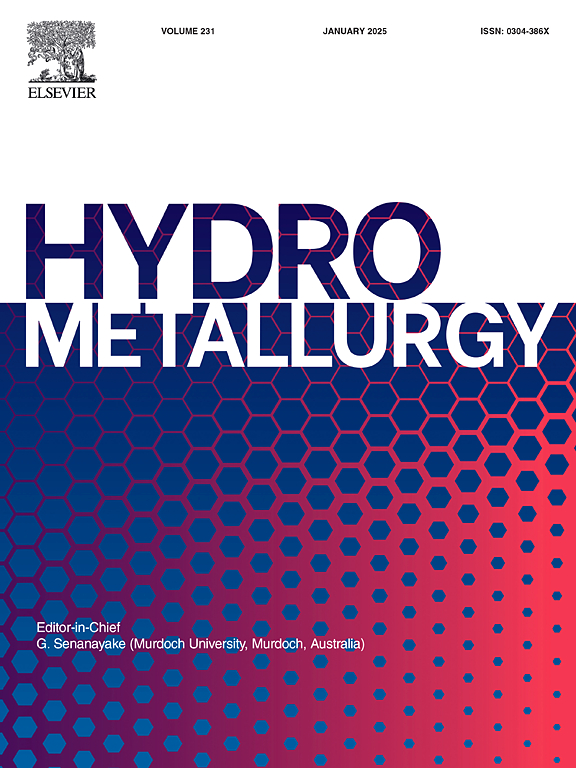影响通过 NaHSO4-H2O 焙烧、水/氨浸出和蒸发结晶从黑钨矿((铁、锰)WO4)精矿制备的准钨酸铵(APT)纯度的因素
IF 4.8
2区 材料科学
Q1 METALLURGY & METALLURGICAL ENGINEERING
引用次数: 0
摘要
传统的钨矿碱性分解工艺面临着巨大的挑战,包括释放大量的危险废物和冗长的程序。提出了一种利用NaHSO4·H2O焙烧白钨矿制备高纯度仲钨酸铵(APT)的新工艺。然而,该方法对黑钨矿((Fe, Mn)WO4)精矿的适用性仍不确定。本文系统研究了NaHSO4·H2O焙烧分解黑钨矿制备APT的工艺过程。结果表明,在NaHSO4·H2O加入量为化学量的3.0倍、焙烧温度为650℃、焙烧时间为120 min的条件下,黑钨矿中钨的转化率为98.6%,焙烧产物主要相为WO3、MnSO4和3Na2SO4·Fe2(SO4)3。并对焙烧产物WO3富集的水浸条件进行了研究。在液固比为6:1 mL/g、搅拌速度为300 rpm、浸出时间为180 min、浸出温度为25℃的条件下,焙烧产物中Fe和Mn的去除率分别为96.5%和99.3%。结果表明,水浸产物(渣)中WO3的浓度由25.2%提高到93.1%。在氨浓度为4 mol/L、液固比为4:1 mL/g、溶解温度为80℃、搅拌速度为350 rpm的条件下,富集WO3的浸出效率达到98.5%,经过120 min后,通过除杂和蒸发结晶得到了高纯度的APT产品。综上所述,NaHSO4·H2O焙烧法在钨矿分解中具有广泛的应用前景。本文章由计算机程序翻译,如有差异,请以英文原文为准。
Factors affecting purity of ammonium para-tungstate (APT) prepared from wolframite ((Fe, Mn)WO4) concentrate by NaHSO4·H2O roasting, water/ammonia leaching and evaporation crystallization
Traditional alkaline decomposition process for tungsten ore is facing significant challenges, including release of large amounts of hazardous waste and lengthy procedures. A previously proposed novel process for scheelite using NaHSO4·H2O roasting yielded ammonium para-tungstate (APT) of high-purity. However, the applicability of this method to wolframite ((Fe, Mn)WO4) concentrate remains uncertain. In this work, the process of wolframite decomposition by NaHSO4·H2O roasting for the preparation of APT was systematically investigated. It was found that 98.6 % of the tungsten in wolframite can be converted into WO3 under the conditions of 3.0 times the stoichiometric amount of NaHSO4·H2O, a roasting temperature of 650 °C and a roasting time of 120 min. The main phases in the roasted product were WO3, MnSO4, and 3Na2SO4·Fe2(SO4)3. Additionally, the water leaching conditions for WO3 enrichment of the roasted product were investigated. At a liquid–solid ratio of 6:1 mL/g, a stirring rate of 300 rpm, a leaching time of 180 min and a leaching temperature of 25 °C, the removal efficiencies of Fe and Mn in the roasted product were 96.5 % and 99.3 %, respectively. Consequently, the concentration of WO3 in the water-leaching product (residue) enriched from 25.2 % to 93.1 %. Furthermore, at an ammonia concentration of 4 mol/L, a liquid–solid ratio of 4:1 mL/g, a dissolution temperature of 80 °C, and a stirring rate of 350 rpm, the leaching efficiency of WO3 in the WO3 enrichment reached 98.5 % after 120 min. Subsequently, an APT product of high purity was obtained through impurity removal and evaporation crystallization. Overall, the results showed that NaHSO4·H2O roasting method has a broad range of applications in the decomposition of tungsten ore.
求助全文
通过发布文献求助,成功后即可免费获取论文全文。
去求助
来源期刊

Hydrometallurgy
工程技术-冶金工程
CiteScore
9.50
自引率
6.40%
发文量
144
审稿时长
3.4 months
期刊介绍:
Hydrometallurgy aims to compile studies on novel processes, process design, chemistry, modelling, control, economics and interfaces between unit operations, and to provide a forum for discussions on case histories and operational difficulties.
Topics covered include: leaching of metal values by chemical reagents or bacterial action at ambient or elevated pressures and temperatures; separation of solids from leach liquors; removal of impurities and recovery of metal values by precipitation, ion exchange, solvent extraction, gaseous reduction, cementation, electro-winning and electro-refining; pre-treatment of ores by roasting or chemical treatments such as halogenation or reduction; recycling of reagents and treatment of effluents.
 求助内容:
求助内容: 应助结果提醒方式:
应助结果提醒方式:


